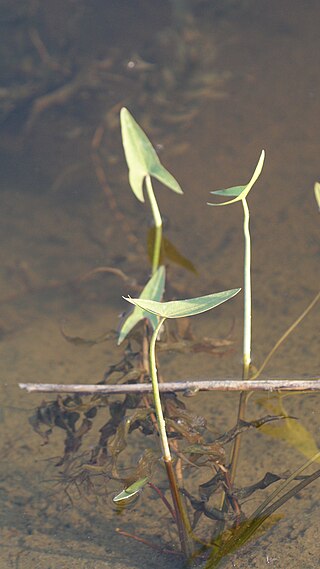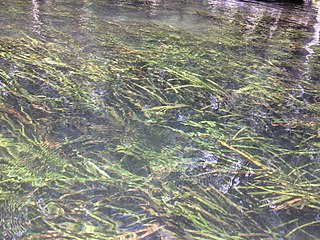
Sagittaria montevidensis is a species of flowering plant in the water-plantain family Alismataceae. Common names include giant arrowhead and California arrowhead.

Sagittaria secundifolia, also known as Kral's water plantain or Little River arrowhead is an endangered aquatic plant endemic to banks along the Little River of the U.S. states of Alabama and Georgia.

Sagittaria lancifolia, the bulltongue arrowhead, is a perennial, monocot plant in the family Alismataceae, genus Sagittaria, with herbaceous growth patterns. It is native to the southeastern United States. It is known from every coastal state from Delaware to Texas. The species is also considered native to Mexico, Central America, the West Indies and northern South America. It has become naturalized on the Island of Java in Indonesia.

Sagittaria cuneata is a species of flowering plant in the water plantain family known by the common name arumleaf arrowhead or duck potato. Like some other Sagittaria species, it may be called wapato. It is native to much of North America, including most of Canada as well as the western and northeastern United States.

Sagittaria longiloba is a species of flowering plant in the water plantain family known by the common name longbarb arrowhead and Gregg arrowhead. It is native to the south-central and southwestern United States plus Mexico, Venezuela and Nicaragua. It is also reportedly naturalized in the western Himalayas of India and Bhutan. It grows in slow-moving, stagnant, and ephemeral water bodies such as ponds and small streams, and sometimes disturbed and cultivated habitat such as rice fields and irrigation ditches.

Sagittaria sanfordii is an uncommon species of flowering plant in the water plantain family known by the common names valley arrowhead and Sanford's arrowhead that is endemic to California, where it is known from a few scattered occurrences on the North Coast and in the Central Valley. Many occurrences previously noted in the Central Valley and in southern California have been extirpated as the plant's aquatic habitat has been lost to human activity.

Sagittaria platyphylla, the delta arrowhead, broad-leaf arrowhead or delta duck-potato, is a plant species native to the eastern United States. The core of its range extends from central Texas to the Florida Panhandle north to southern Illinois.

Sagittaria isoetiformis, common name quillwort arrowhead, is an aquatic plant species native to Cuba and to the southeastern United States.

Sagittaria rigida, the sessilefruit arrowhead or Canadian arrowhead, is an aquatic plant species native to Canada and to the United States and also naturalized in Great Britain. It grows in shallow waters along the edges of ponds and streams. What is really interesting is that it has narrow oval leaves rather than the iconic arrowhead shaped leaves of species like the Sagittaria latifolia. it has sessile female flowers, which is where it gets its name from. Its flowers are very similar to other plants in the Sagittaria family, with three white petals. It grows "potato" like tubers which can be eaten. Gathering any tubers from the Sagittaria family can be dangerous if gathered from polluted water.

Sagittaria kurziana, common names springtape and strap-leaf sagittaria, is an aquatic plant species native to Florida and naturalized in the Mariana Islands. It grows along large springs, very often those with high sulfur content, and along the banks of watercourses downstream from such springs.

Sagittaria cristata, the crested arrowhead, is a plant species native to Ontario and north-central United States. It grows in shallow water along the edges of lakes, streams and marshes.

Sagittaria teres, the quill-leaved arrowhead or slender arrowhead, is an aquatic plant species in the genus Sagittaria native to the northeastern United States: Rhode Island, Massachusetts, New Hampshire, New York and New Jersey.

Sagittaria ambigua, the Kansas arrowhead, is an aquatic plant species native to the central United States. It grows in wet areas, mostly along the shores of ponds and waterways.
Sagittaria demersa, commonly called Chihuahuan arrowhead, is an aquatic plant species native to north-central Mexico and also from a few sites in the northern part of the US State of New Mexico.

Sagittaria brevirostra, common name Midwestern arrowhead or shortbeak arrowhead, is an aquatic plant species native to North America. It is common in wet places in an area stretching from Michigan and Ohio south to Alabama and west to North Dakota, Colorado and northern New Mexico, plus isolated populations in Maryland, New Brunswick, Virginia, Saskatchewan and California.

Sagittaria filiformis, the threadleaf arrowhead, is an aquatic plant species native to the eastern United States, from Maine south to Florida and Alabama. it occurs in flowing streams in the northern part of its range, but more stagnant waters such as marshes and swamps in the South.

Sagittaria engelmanniana is an aquatic plant species native to eastern North America. It has been reported from every state bordering on the Gulf of Mexico or on the Atlantic Ocean from Mississippi to Massachusetts, plus Vermont and Ontario.

Sagittaria graminea, the grassy arrowhead or grass-leaved arrowhead, is an aquatic plant species native to eastern North America.

Sagittaria guayanensis, the Guyanese arrowhead, is an aquatic plant species. It is predominantly tropical, native to Mexico, Central America, the West Indies, and much of South America, as well as West Africa, south and southeast Asia, plus Sudan and Madagascar. It was unknown in the United States until a few populations were reported from Louisiana in 1969.

Sagittaria subulata, the awl-leaf arrowhead, narrow-leaved arrowhead or dwarf sagittaria, is an aquatic plant species that grows primarily in shallow brackish water along the seacoast, in marshes, estuaries, etc. It is native to the Colombia, Venezuela, and every US state along the coast from Massachusetts to Louisiana. It has also been reported as naturalized in Great Britain on just three occasions; only one of these is recent and it appears to have become extinct by 2010. It is also recorded as a non-native on the Azores, and on the Island of Java in Indonesia.



















